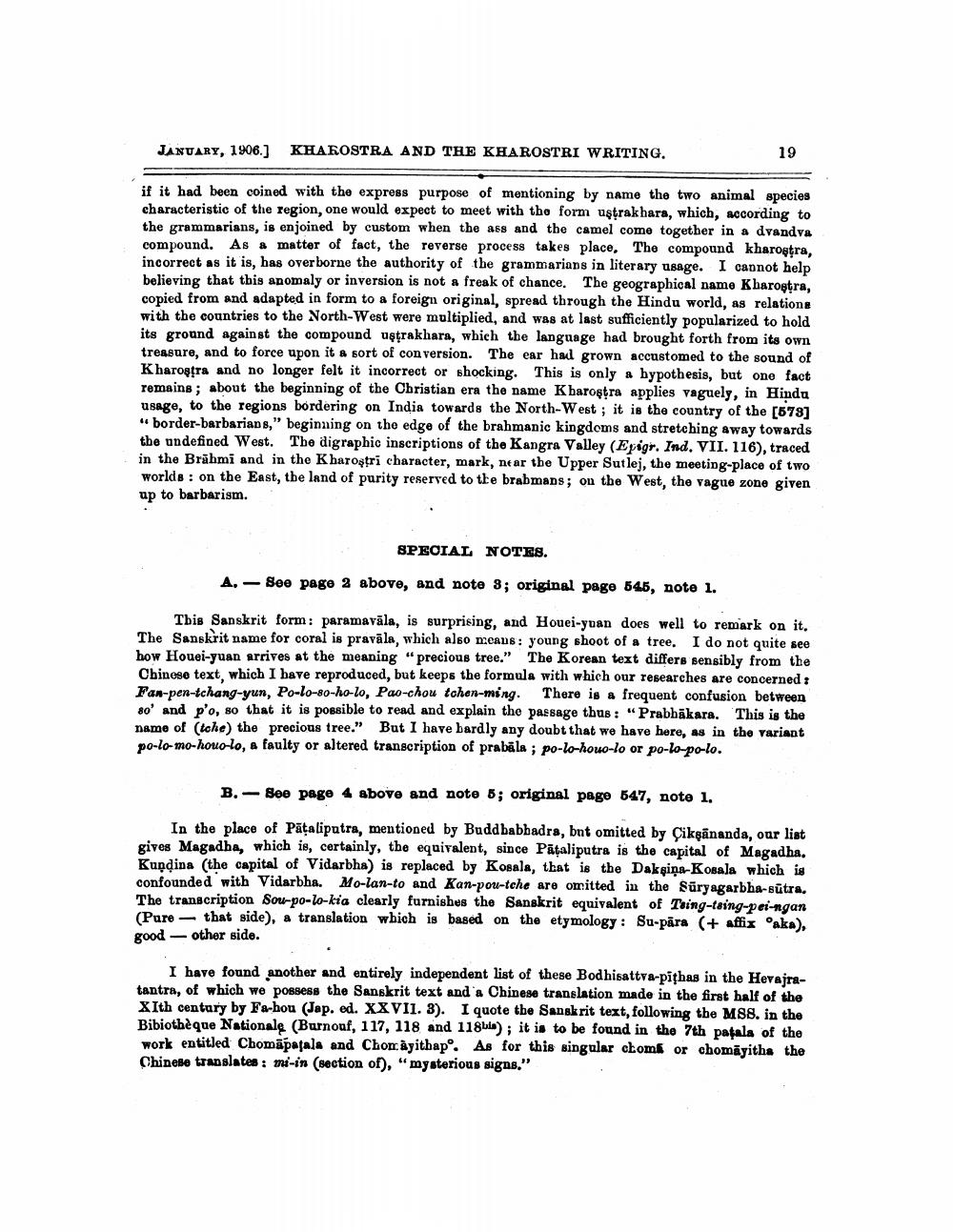________________
KHAROSTRA AND THE KHAROSTRI WRITING.
JANUARY, 1906.]
if it had been coined with the express purpose of mentioning by name the two animal species characteristic of the region, one would expect to meet with the form ustrakhara, which, according to the grammarians, is enjoined by custom when the ass and the camel come together in a dvandva compound. As a matter of fact, the reverse process takes place. The compound kharoştra, incorrect as it is, has overborne the authority of the grammarians in literary usage. I cannot help believing that this anomaly or inversion is not a freak of chance. The geographical name Kharoştra, copied from and adapted in form to a foreign original, spread through the Hindu world, as relations with the countries to the North-West were multiplied, and was at last sufficiently popularized to hold its ground against the compound ustrakhara, which the language had brought forth from its own treasure, and to force upon it a sort of conversion. The ear had grown accustomed to the sound of Kharogtra and no longer felt it incorrect or shocking. This is only a hypothesis, but one fact remains; about the beginning of the Christian era the name Kharoştra applies vaguely, in Hindu usage, to the regions bordering on India towards the North-West; it is the country of the [578] "border-barbarians," beginning on the edge of the brahmanic kingdoms and stretching away towards the undefined West. The digraphic inscriptions of the Kangra Valley (Epigr. Ind. VII. 116), traced in the Brahmi and in the Kharoştri character, mark, near the Upper Sutlej, the meeting-place of two worlds on the East, the land of purity reserved to the brabmans; on the West, the vague zone given up to barbarism.
19
SPECIAL NOTES.
A. See page 2 above, and note 3; original page 545, note 1.
This Sanskrit form: paramavala, is surprising, and Houei-yuan does well to remark on it. The Sanskrit name for coral is pravala, which also means: young shoot of a tree. I do not quite see how Houei-yuan arrives at the meaning "precious tree." The Korean text differs sensibly from the Chinese text, which I have reproduced, but keeps the formula with which our researches are concerned: Fan-pen-tchang-yun, Po-lo-so-ho-lo, Pao-chou tchen-ming. There is a frequent confusion between so' and p'o, so that it is possible to read and explain the passage thus: "Prabhakara. This is the name of (tche) the precious tree." But I have hardly any doubt that we have here, as in the variant po-lo-mo-houo-lo, a faulty or altered transcription of prabala; po-lo-houo-lo or po-lo-po-lo.
B.
See page 4 above and note 5; original page 547, note 1.
In the place of Pataliputra, mentioned by Buddhabhadra, but omitted by Çiksananda, our list gives Magadha, which is, certainly, the equivalent, since Pataliputra is the capital of Magadha. Kundina (the capital of Vidarbha) is replaced by Kosala, that is the Daksina-Kosala which is confounded with Vidarbha. Mo-lan-to and Kan-pou-tehe are omitted in the Suryagarbha-sutra. The transcription Sou-po-lo-kia clearly furnishes the Sanskrit equivalent of Tsing-teing-pei-ngan (Pure that side), a translation which is based on the etymology: Su-pära (+ affix aka), good-other side.
I have found another and entirely independent list of these Bodhisattva-pithas in the Hevajratantra, of which we possess the Sanskrit text and a Chinese translation made in the first half of the XIth century by Fa-hou (Jap. ed. XXVII. 3). I quote the Sanskrit text, following the MSS. in the Bibiothèque Nationale (Burnouf, 117, 118 and 118bia); it is to be found in the 7th patala of the work entitled Chomapatala and Chom ayithap. As for this singular choma or chomayitha the Chinese translates: mi-in (section of), "mysterious signs."




